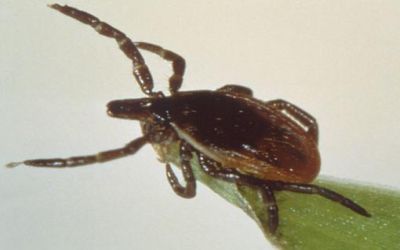First Multiplex Test for Tickborne Diseases
A new blood test called the Tick-Borne Disease Serochip (TBD Serochip) promises to revolutionize the diagnosis of tickborne disease by offering a single test to identify and distinguish between Borrelia burgdorferi and seven other tickborne pathogens.

A new blood test called the Tick-Borne Disease Serochip (TBD Serochip) promises to revolutionize the diagnosis of tickborne disease by offering a single test to identify and distinguish between Borrelia burgdorferi, the pathogen responsible for Lyme disease, and seven other tickborne pathogens. Led by scientists at the Center for Infection and Immunity (CII) at Columbia University's Mailman School of Public Health, the research team report details on the new test in the journal Nature: Scientific Reports.
The researchers -- who also include scientists from the Centers for Disease Control and Prevention, National Institute of Allergy and Infectious Diseases, Roche Sequencing Solutions, Farmingdale State College, and Stony Brook University -- sought to improve on existing tests for tickborne diseases (TBDs), which have limited diagnostic accuracy and cannot test for more than one infection simultaneously. Currently, diagnosis of Lyme disease, the most common TBD, requires two separate tests. This cumbersome approach also relies on subjective criteria for the interpretation of results, and accurately identifies fewer than 40 percent of patients with early disease and results in false positives in 28 percent of the time. The accuracy of the method used to diagnose TBDs Babesia, Anaplasma, Ehrlichia, and Rickettsia varies widely among testing laboratories. And for other tick-borne agents, specific blood tests are not yet available, or in the case of the potentially deadly Powassan virus or Heartland virus, are only performed in specialized laboratories.
"The number of Americans diagnosed with tickborne disease is steadily increasing as tick populations have expanded geographically," says Rafal Tokarz, PhD. "Each year, approximately 3 million clinical specimens are tested for TBDs in the U.S. Nonetheless, the true incidence of TBDs is likely greatly underestimated, as patients with presumed TBDs are rarely tested for the full range of tick-borne agents, and only a fraction of positive cases are properly reported," adds Nischay Mishra, PhD. Co-lead authors Tokarz and Mishra are associate research scientists in the Center for Infection and Immunity.
The TBD Serochip can simultaneously test for the presence of antibodies in blood to more than 170,000 individual protein fragments. Version 1.0 can identify exposure to eight tickborne pathogens present in the U.S., including Anaplasma phagocytophilum (agent of human granulocytic anaplasmosis), Babesia microti (babesiosis), Borrelia burgdorferi (Lyme disease), Borrelia miyamotoi, Ehrlichia chaffeensis (human monocytic ehrlichiosis), Rickettsia rickettsii (Rocky Mountain spotted fever), Heartland virus and Powassan virus. The researchers also included Long Island tick rhabdovirus, a novel virus they recently discovered in Amblyomma americanum ticks. As new tickborne infectious agents are discovered, the TBD-Serochip will be modified to target them--a process the researchers say can be done in less than four weeks.
The TBD Serochip is also able to identify whether an individual is infected with more than one tick-borne pathogen. Individual ticks are frequently infected with more than one agent; Ixodes scapularis ticks alone can transmit at least five human pathogens. Evidence of exposure to other tick-borne pathogens in patients with Lyme disease has been well documented. In the new paper, the researchers report finding antibodies to another agent in 26 percent of blood specimens from patients with TBD.
In addition to its utility as a diagnostic platform, the TBD Serochip also provides a powerful research tool for studies of TBDs. The technology can be employed to discriminate individual antibody responses in patients with TBD and thus examine the interplay of TBD agents on disease manifestation and progression. It can also be used to assess the impact of genetic diversity of tick-borne pathogens on the host immune response.
"Diagnosing tick-borne illness is a difficult journey for patients, delaying effecting treatment," says senior author W. Ian Lipkin, MD, director of CII and John Snow Professor of Epidemiology at Columbia University's Mailman School of Public Health. "The TBD Serochip promises to make diagnosis far easier, offering a single, accurate test for eight different TBDs. Early detection of infection enables rapid and appropriate treatment."
Co-authors include Thomas Briese, Teresa Tagliafierro, Stephen Sameroff, Adrian Caciula, Lokendrasingh Chauhan, of CII; Jigar Patel and Eric Sullivan of Roche Sequencing Solutions, Madison, WI; Azad Gucwa of Farmingdale State College, Farmingdale, NY; Brian Fallon of Columbia University; Marc Golightly of Stony Brook University; Claudia Molins and Martin Schriefer of Centers for Disease Control and Prevention; Adriana Marques of National Institute of Allergy and Infectious Diseases.
Source: Columbia University's Mailman School of Public Health
Robust infectious disease surveillance, including rapid subtyping of influenza A, is essential for early detection, containment, and public health reporting of novel viral threats.